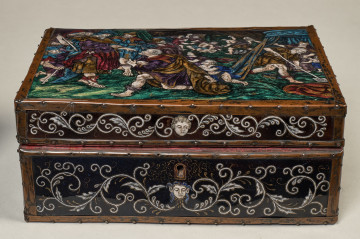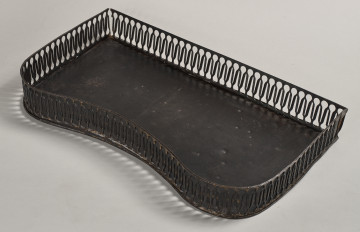
Enamel cassette
17th-18th (?) century
Castle Museum in Łańcut
Part of the collection: European classics of modernity
Wojciech Gerson began his education in 1839 at the Second Philological Gymnasium in Warsaw. Between 1844 and 1850, he studied at the local School of Fine Arts, first at the Faculty of Architecture, then at the Faculty of Painting, in the ateliers of Jan Chrystian Breslauer, Feliks Piwarski and Marcin Zaleski. The first of them, an outstanding landscape painter after his Düsseldorf training, awakened Gerson's interest in landscape. Between 1849 and 1853, the young artist joined the so-called Warsaw Bohemians, with whom he travelled on foot through the Kielce region, the Lublin region, Mazovia and Kujawy, the Vilnius region and the Kowno region. Between 1853 and 1855, Gerson graduated from the Imperial Academy of Fine Arts in Saint Petersburg. In the year of his graduation, he painted an intimate landscape on copper plate, which found its way into the Szczecin collection. The vast landscape with a lowered horizon line shows in the foreground a bent bush growing on a small hill. In the background, at the foot of a sandy hill with a windmill, there is a small staffage - a peasant with a pair of oxen pulling a plough. Above the dark line of the forest, a study of the sky covered with billowy clouds - the main subject of the painting - occupies a large part of the painting. The brownish-blue colour palette, the composition and the choice of motifs are reminiscent of the convention of 17th-century Dutch painting, appreciated by the artists of the emerging realism. The artist returned to this idea a decade later, creating the horizontal Krajobraz pochmurny z krowami [The Cloudy Landscape with Cows] (National Museum in Poznań). The copper sub-image was an unusual one, although it was used in the 19th century. On this ground Gerson produced a series of paintings for the passenger ships of the Steam Navigation Company on the navigable rivers of Count Zamoyski's Kingdom. The deck of the Płock (1852) and Włocławek (1853) were decorated with views of cities and architectural monuments, while the Narew or Niemen (1856-1857) a series of seven Polish trees. Pejzaż z wiatrakiem [The landscape with a Windmill] is probably the result of commissions from Zamoyski, which were also accepted at that time by Julian Cegliński and Franciszek Kostrzewski.
Szymon Piotr Kubiak
Author / creator
Dimensions
cały obiekt: height: 34 cm, width: 25 cm
Object type
painting
Creation time / dating
Creation / finding place
Identification number
Location / status

17th-18th (?) century
Castle Museum in Łańcut

20th century
Castle Museum in Łańcut

2nd half of the 18th century
Castle Museum in Łańcut
DISCOVER this TOPIC
Castle Museum in Łańcut
DISCOVER this PATH
Educational path